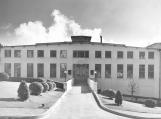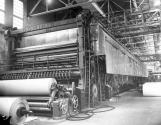18
Number 5 and 6 Paper MachinesCirca 1930
Powell River, British Columbia, Canada
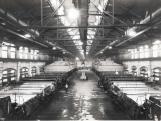 Credits:
Credits:A27-13-1
Leonard Frank, photographer
19
In spite of greatly increased production, it was not long before the demand for Powell River newsprint again exceeded the mill's capacity and further expansion was necessary.In 1930, another building, designed to house two larger and faster paper machines, was constructed. Because of the economic conditions--"the Great Depression"--of the time, only one machine was installed.
Bill Thompson,
The Powell River Mill Story
21
No. 7 Machine, described by the Powell River Digester as the final word in newsprint machine construction, was built by Dominion Engineering. It was a 1600 ton giant with suction couch, suction presses, a removable fourdrinier to facilitate and speed up wire changing, and 52 drier rolls. Powered by a Harland sectional direct current electric drive, the machine was designed to produce a sheet 214 inches wide at 1400 feet per minute and increase daily production by 150 tons (more than the combined production of Nos. 1 and 2 Machines. On December 30, 1930, No. 7 began producing salable newssprint,..............Bill Thompson,
The Powell River Mill Story
22
Construction, Number 7 Paper MachineCirca 1930
Powell River, British Columbia, Canada
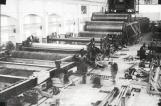 Credits:
Credits:A18-40-1
23
The decision to install No. 8 Machine was announced late in 1946. No. 8 was the same width as No. 7. Built by Dominion Engineering Works Ltd. in Quebec, it was the first newsprint machine installed in Canada in 11 years. Most of the equipment required for it was made in Canada. No. 8 was set up beside No. 7 in the building constructed in 1930 for two identical machines.Bill Thompson
The Powell River Mill Story
24
Head box and Wet End, Number 8 Paper Machine2 September 1948
Powell River, British Columbia, Canada
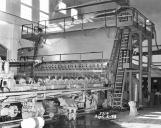 Credits:
Credits:P00856
25
Electronic controls which were not available to No. 7 Machine in 1930 were included in No. 8 design. The stock inlet system, developed by Powell River Company engineers after extensive discussion with operating personnel, was of an entirely new design, operating with constant level and variable pressure.Bill Thompson,
The Powell River Mill Story
26
Wet end control panel, Number 8 Paper Machine26 October 1948
Powell River, British Columbia, Canada
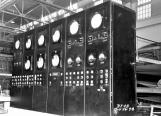 Credits:
Credits:P00810
27
The drier section contained 52 main driers and 10 felt driers. The Pope reel, on which the finished sheet is wound as it comes from the calender, was designed to handle enough paper for two runs through the winder, saving time in moving reels from paper machine to winder.Bill Thompson,
The Powell River Mill Story
29
No. 8 was the fastest and most modern paper machine in existence at the time. It would increase the mill's newsprint production by about 10 percent (some 25,000 tons per year) and make it the largest individual newsprint plant in the world. However, even this increased output would not meet world demand. War time conditions had limited production for several years and shortages were expected to increase.Bill Thompson,
The Powell River Mill Story
30
Number 7 and 8 Paper Machine RoomCirca 1950
Powell River, British Columbia, Canada
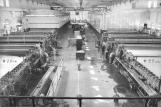 Credits:
Credits:A11-41-4
Al Pauling
31
In 1955 the company announced the decision to install No. 9 paper machine.It was a huge project. Half a million cubic yards of earth were excavated for the building. Twenty thousand cubic yards of concrete were poured into forms requiring 2 million board feet of lumber and about 1,300 tons of reinforced steel. The building required 800 tons (300 miles) of structural steel.
Bill Thompson,
The Powell River Mill Story
